Is anyone hot?
The gorgeousness of July; also serious things like weight loss injections, coffee, constipation, creatine, cholesterol and cancer nutrition; And your favourite, From the Dog Basket.
July is my favourite month because it’s sunny and m’birthday is in it – simple things. And this year, on what seems like the 102nd birthday, I unwrapped a much-longed-for cast iron bread cloche, which will obviously change my life completely. July is also a bit heatwavey lately, and while climate change is a very big concern, it makes a lovely change from the long, looooong, neverending winter and being bundled up in four anoraks, wellies and a bobble hat (indoors). Instead, one can prance about in crop tops, Jesus sandals and wotnot, soaking in all the vitamin D, and not being slathered in mud every single day. I’m never going to complain that it’s too hot, because I know how fast September comes along – like any minute now.
The other thing about July is that it brings us deliciousness in the form of juicy tomatoes, strawberries, runner beans, home-grown courgettes, and you-name-it vegetables and soft fruits. Heaven. And you can eat outdoors if you want to, or have your morning cuppa on the back doorstep with the dogs and it’s already 24º. And in the evening it’s still all warm and balmy and you can go up the fields and watch hares and fox cubs doing evening dances. And harvest starts, so the air is filled with that gorgeous warm dry cut-crop smell and the countryside gets all industrious with combine harvesters and corn carts and balers.
OMG, it’s bloody lovely.
Weight loss drugs in the news
There is little doubt that use GLP-1 weight loss drugs can move people who have obesity away from life-limiting chronic disease, like type 2 diabetes, high blood pressure, unbalanced cholesterol, and so on. And reaching and staying at a healthy level of body fat can absolutely reduce the risk of other diseases, including cancer. This is all great. Used responsibly these drugs can improve life, lifespan and healthspan (that’s the number of healthy years in your life). They can reduce the urge to overeat and to eat poor quality foods, and they provide a brilliant opportunity to change to a healthy diet and lifestyle, and to ingrain wonderful new healthy habits.
This is also good for me as a nutritional therapist, because it makes my job easier. People are like “Yes I can do it!” when I ask them to eat more vegetables, whole grains, pulses, healthy fats and proteins. Whereas before, they had a voice in their head driving them towards less healthy foods. So these drugs can help people to comply with healthy eating advice and learn that they can do it, and that it feels good.
However (there’s always a however!), recent UK reports have brought up a possible link between GLP-1 medications, like Ozempic, Wegovy and Mounjaro, and cases of acute and chronic pancreatitis. The Medicines and Healthcare products Regulatory Agency (MHRA) has received over 560 Yellow Card reports, including more than 180 associated with tirzepatide (Mounjaro), with a small number of deaths. While causality isn’t yet confirmed, and the overall risk is considered low, pancreatitis is a recognised but uncommon side effect of these drugs. In response, the MHRA and Genomics England have launched a study through the Yellow Card Biobank to investigate whether certain genetic traits might increase susceptibility to pancreatitis in people taking GLP-1s. The initiative aims to enable more personalised and safer prescribing – hurray.
Some other potential downsides include the loss of muscle that can be seen with rapid weight loss. Muscle loss is generally connected with poorer metabolism and health, and is a very bad thing. Certainly not something I want to see in any of my clients, or anyone at all, actually. Another problem is that some people do not use the opportunity to eat better, they simply carry on eating a poor quality diet, but less of it. Malnutrition is a serious risk and this can be seen in the higher rates of hair loss observed in a percentage of users, for one thing – although there’s also a theory that the drug can affect thyroid hormone balance, which can also induce hair loss. And, worryingly, these drugs can get into the wrong hands, and people who don’t need to lose weight start to use them, and they either facilitate or trigger an eating disorder. Finally, when people stop the drug they can just regain the weight, and more – that’s why it’s super important to fundamentally change the food relationship while using the drugs.
Are you using a GLP-1 for weight loss, or considering doing so? If so, I am here to support and guide you to get the most out of your experience, and to make positive changes for life, keeping the weight off for good, and staying robust and healthy.
Coffee – is it good or bad for you?
I’ve always been a tea addict and have only drunk coffee very occasionally, when out. But lately I’ve been trying harder with coffee because of its reported polyphenol benefits. So I got myself some Exhale coffee beans and a hand-grinder, and set-to with my cafêtiere. I love the ritual, and the coffee is growing on me too. But I couldn’t have more than one a day because I’d miss my tea, plus it’s been giving me some serious prangs in the tummy department - at least I think it’s the coffee as it’s the only thing that has changed!
Anyway, I decided to do a deep-dive into the health effects of coffee, and discovered something surprising. Despite its rich polyphenol credentials, it can increase LDL cholesterol – that’s the oft-labelled ‘bad’ kind!
Coffee beans are seeds, and like a lot of other seeds (think rapeseed or sunflower seed), they naturally contain oils. The oils move toward the surface during roasting and get drawn out during brewing, especially if the coffee isn’t filtered through paper. That’s why you sometimes see a little bit of an oily sheen on the top of a strong brew, and why unfiltered coffee tastes richer or feels heavier in the mouth.
The problem is that these natural oils contain things called diterpenes – mainly cafestol and kahweol – which can increase LDL cholesterol. They do this by getting in the way of your liver using cholesterol to make things called bile acids. They block that process a bit, so more cholesterol stays in your bloodstream, particularly in the form of the less desirable LDL.
These compounds are well-caught by paper filters, so filtered coffee has very low levels and doesn’t carry anywhere near the same amounts of diterpenes. Espresso, French press, boiled coffee and Moka pot coffee don’t use paper, so more of the diterpenes end up in your cup. Trouble is, I don’t really want to brew up paper fibres in m’drink, so it’s a dilemma.
Before all the coffee-drinkers start panicking, if you only have one or two small cups a day, and everything else in your diet and lifestyle supports heart health, and your cholesterol balance is healthy, it’s unlikely to cause much trouble. I would only worry if your LDL (and non-HDL) cholesterol is already high.
It’s not about cutting out coffee altogether – just being a bit mindful of how it’s made, and what’s right for your own body.
Personal responsibility
“Eat food, not too much, mostly plants” is a quote by Michael Pollan, a journalist and author known for writing about food, health and the environment.
It’s a strong basis for eating well, but it’s hard for many people to put into practice. We’ve lost our connection with where food comes from and the work and resources it takes to grow it. We eat too much and waste too much, and it harms both us and the planet. A third of global greenhouse gas emissions come from the food system – growing, processing, transporting and storing food. And around 30–40% of all food produced is wasted. That waste comes from growers, sellers, storage, and us – the consumers, big time.
If we each bought only what we truly needed, and used it all, we could make an enormous difference – reducing pressure on the planet and our health systems, and improving the quality and length of our lives.
But it’s far from easy. I’ve been in this job a long time and I can tell you that it’s a hard thing getting people to change, although there have been lots of successes along the way. We’re surrounded by food and by chances to eat, and we’re biologically wired to store calories when they’re available – and they’re always available. Some people can resist it, but many more can’t. Add to that the culture of wanting everything and wanting it now, and being able to get almost anything fairly immediately and you can see why overweight, obesity and related ill-health are so prevalent.
Many people have become so disconnected from, but at the same time addicted to, food that quantity has hugely overtaken quality. Our diets are full of ultra-processed foods (and alcohol) that we know are doing us no good – and yet we keep eating them. We’d rather buy 2-3 bottles of wine a week than spend on a bottle of good olive oil. Even when quality is there, quantity can still prevail, but it’s a bit harder to gain weight because healthy, whole foods, can be so much more satiating. Harder, but by no means impossible.
It’s difficult to imagine anything other than a major catastrophe changing our behaviour, and none of us wants that but neither do we want to be sick. So if we actually want to change, whether for our health or the environment, or both, that change has to come from us as individuals. Yes, I’m talking about the uncomfortable but necessary idea of personal responsibility. I can support, guide and encourage – but I can’t be with someone every time they shop and eat. That part’s up to them. And it takes grit to swim against the tide of the food environment and culture. But grit is a necessary skill.
Some people avoid learning about nutrition and about food provenance, partly because there is so much guff written about it and I think they are now numb to it, or sometimes they just don’t want to know because we’ve all become so detached from it that it seems not to matter; surely our bodies just sort themselves out and we can eat whatever we like?! Unfortunately not. Your body needs your care and attention.
I encourage people to look into the detail, learn the whys and wherefores, learn to really appreciate good food and where it comes from, so they can savour it - eating at the table, cooking from scratch, not wasting it, and so on. We each own a piece of absolute magic, our bodies, and if we had to buy such a complex piece of equipment it would cost millions of pounds but we tend to take it for granted.
If you’re ready to get serious about changing your diet, I’d love to help you. I’ll be your scaffold and advocate, and I’ll pick you up when you get knocked over. But you will need to be absolutely and properly on board so that we can fight the system and tide together!
Ready to start? Get your nutrition plan
I just wanted to show you this smashing olive oil I got for m’birthday
Oh crikey, it’s beautiful and delicious - you can really taste the polyphenols. Apparently it’s ranked in the world’s top 20 olive oils. I never want it to run out. Thanks to my brother and sister-in-law for this top prezzie.
Let’s talk about constipation
I used to be very British about all things to do with the far end, but since being on the job (‘scuse pun) for so many years I have begun to talk about bowel habits with abandon and even enthusiasm.
About 1 in 7 UK adults, and 1 in 3 children suffer constipation. Women are twice as likely as men to have it, and hospital admission cases for children. have gone up by 60% over the last decade, with 44,000 hospital cases a year. Not good.
Some really common reasons for constipation are:
Not consuming enough fibre - my clients, this is one of the reasons I get on at you to eat lots of veg!
Eating a poor quality diet high in ultra processed food, refined carbs and sugars.
Not drinking enough fluids.
Not exercising or moving much, or being physically inactive.
Being chronically stressed.
Use of certain medications like antacids, anti-depressants, weight loss injections, certain pain killers, laxatives (strangely!).
Ignoring the urge to go.
Hormone changes that affect gut movement.
Travel - because the gut is a creature of habit!
What defines constipation?
Two or more of the following for at least three months:
Fewer than 3 bowel movements per week
Straining during more than 25% of bowel movements
Passing hard or lumpy stools
Feeling of incomplete emptying
Sensation of blockage or obstruction
Needing manual help to pass stool (e.g. pressing on abdomen or using fingers)
Look at the chart below, if you are a 1 or 2, it’s somewhat likely that you are constipated.
The Bristol chart is helpful, but it doesn’t tell the whole story. Constipation is also about how often you go, how easy it is to go, and whether you feel fully emptied. Some people feel constipated even if their stool looks normal, and some don’t, even if it looks hard!
If your bowel habits have changed, or if you are regularly constipated you must talk to your GP. Once that is done, you can work with me and we will do all we can to get you going again comfortably and often!
Book your free 15 minute discovery call
Creatine – bro-science or bonafide?
Creatine tends to be one of those supplements that gets loads of hype and, even though its use and benefits are quite well evidenced, it gets blown out of proportion a bit. I always say, re supplements, no point throwing a load of supplements down your neck and hoping for good health if you don’t have a good diet and lifestyle. There are no easy fixes!
Anyway, it’s well-studied, generally safe and widely used and, when taken in the right context, can be very helpful. But it’s not a magic potion, and it’s certainly not essential for most people.
Naturally found in meat and fish, creatine helps to make energy in our cells, particularly during short bursts of high-intensity activity. Its magic lies there, especially so in muscle and brain tissue. This explains why it can be a boon for exercising types. Increasingly, research is showing creatine’s positive effects on cognitive function, mental health and healthy ageing. Some studies suggest it might support memory, focus and mood, particularly in people under stress or experiencing brain fog.
Side effects are usually mild, with occasional digestive discomfort or water retention in some cases. As always, the benefits come when it’s used thoughtfully and appropriately, rather than as a quick fix. Like many things in nutrition, context is everything. It can be a helpful tool for the right person, but it's not something everyone needs to start taking just because it’s trending.
There’s often confusion between creatine and creatinine when it comes to kidney health. Creatinine is a waste product that doctors measure to check how well your kidneys are working. Taking creatine supplements can raise creatinine levels slightly, but this doesn’t mean your kidneys are harmed, it’s just a normal effect of creatine metabolism. The only thing is it can skew any kidney function tests.
For people with healthy kidneys, research shows creatine is safe when used as directed. If you have kidney problems, it’s best to check with your doctor before starting any supplements.
Been thinking about trying it? Talk to me first!
Cholesterol
I’m going to try and simplify it a lot, because it can be so confusing.
Cholesterol, whatever type it’s labelled as, is basically the same fatty substance. Your body needs it big time to build healthy cell membranes and hormones, and to synthesise vitamin D and bile acids. What sets apart the different types is the ‘wrapper’ that carries it around your bloodstream. It needs a wrapper made of protein because cholesterol is fatty and blood is watery and the two don’t really get on that well. So imagine the fatty cholesterol living inside tiny golf balls floating in your blood. Some of these golf balls have thick protein shells, some have thin protein shells, and some are small and they dart about, like TINY solid balls.
The ones with thin shells ( LDL or ‘bad’ cholesterol) are the less desirable kind. Their thin coating means they can leak cholesterol into places they shouldn’t, like the walls of your blood vessels. The small, quick ‘pingy’ ones can ping into blood vessel walls, sit there and cause havoc. Meanwhile, the thick-shelled golf balls (HDL or ‘good’ cholesterol) do the opposite, they safely carry cholesterol to where it’s needed and help sweep up the harmful stuff along the way.
We tend to have more of the ‘bad’ types when we eat a diet high in ultra-processed foods, too much saturated fat, sugary foods, refined carbs and alcohol. Smoking, lack of exercise, stress and carrying excess belly fat also increase the bad cholesterol.
On the other hand, we get more of the good cholesterol if we maintain a healthy level of belly fat, eat plenty of vegetables, fruits, whole grains and healthy fats like olive oil, avocados, nuts and seeds, and we limit our intake of saturated fat. Managing stress, staying active, getting good sleep, not smoking, and limiting alcohol really help too.
What about cholesterol that found in foods? Well, it seems that it isn’t the cholesterol that is in certain foods, such as organ meats, red meat, shellfish and egg yolks, that has a detrimental effect (in fact that dietary cholesterol has very little effect on your blood cholesterol readings), it’s the saturated fats found in all saturated fatty foods – that includes coconut oil, palm oil, chocolate, processed foods such as commercial cakes and biscuits, and so on. So it’s high amounts of saturated fat, rather than the actual cholesterol in certain foods, that prangs up cholesterol balance in the body.
A Mediterranean-style diet, is a diet that has reams of positive research showing that it’s one of the best for healthy cholesterol balance. I didn’t choose it as our dietary basis for nothing!
Find your Mediterranean diet plan
Can food cure cancer?
That’ll be a hard no, actually.
Did you see that recent news story where a young woman’s ‘alternative medicine’ mother dissuaded her from having conventional cancer treatment, and instead encouraged her to use alternative methods like coffee enemas, juicing and all manner of craziness? Sadly, and unsurprisingly, the girl died, although her mum is blaming it on the NHS... I won’t link it here in case I get sued, but you get the gist! The mother still has an Instagram account with a gazillion followers who she also takes along on her juicing and alternative madness journey. I beg you, reader, never to squirt coffee up your bum, or anything else up there for that matter!
What can food and lifestyle do for people with cancer? Lots of good things, It can help someone to build up strength and resilience ready to have treatment. It can support the immune system, which comes under lots of pressure in a cancer situation. It can give the person agency at a time when they are feeling as if everything is being ‘done to’ them. It can help them to maintain weight instead of losing weight and becoming weak, it can help them to tolerate treatment and it can help them to recover from treatment.
It is not a replacement for medical care, it sits strongly alongside it though. And we are not talking about juices and weirdness, we are talking about good wholesome foods that taste nice.
If you have cancer, or someone you know or love has it, I can support you or them prior to and after treatment, helping to prepare for and recover from treatment with nourishing food, and lifestyle tweaks.
Cases I’m working on at the mo
This job is very fulfilling and varied, I love it so much and it’s a privilege to be in a position to help so many people. Every nutritional therapy client brings a new set of symptoms and combination of health conditions with them. It’s my job to look at everything that is going on with their bodies and lives, and to find a way of nourishing them and working on their lifestyle to get them feeling good again.
At the moment I’m working with the following conditions
Obesity
Rheumatoid arthritis
High cholesterol
Hypertension
Hypothyroidism
Prostatitis
Prostate cancer recovery
Parkinson’s disease
Hormone imbalance (both sexes), including menopause
Autoimmune gastritis
Type 2 diabetes
Type 1 diabetes
Reflux
Chronic inflammation
Inflammatory Bowel disease
IBS
Eczema
Pre-cancer-treatment nutrition
If you are struggling to manage your diet and lifestyle around symptoms or a diagnosed health condition, do book a free discovery call so we can discuss how to work together to get you feeling better.
Get a free discovery call here and start you nutritional therapy journey
From the dog basket
I know you’ve all been waiting hear about Sedge’s ‘googlers’ and whether they have migrated to their rightful place. Well I can tell you that they have! I was at a funeral and got chatting to a vet. He suggested that I ‘manipulated them down by hand’. I said “What sort of female do you think I am?!” but that evening I braced myself and thought I’d give it a whirl. OMG. Sedge was having none of it, of course. He was like “Mum, wot are yew evun doing to my ball-eees, this is IMBARRISSINGK, get off pleez!” and he refused to keep still, which I was actually quite relieved about. But never fear, the thought of it all must have triggered a fight or flight hormone response, and a few days later, hey presto, ball-ees are firmly in place. Not that it seems to have changed him from the great big lummoxy pup that he always was. He’s still like Scooby Doo if he senses danger - you should try having a 20kg dog jump up into your arms, shaking when he hears a strange noise. You can see Sedge in one of the pictures below, when I caught him apparently “Tryingk to fix yor barskit, mum.”….


Evie has been quite naughty. She has taken to only following us for about 200 metres on a walk up the fields, before very very quietly turning around and legging it like billio back to the car at 100mph, for a dog with 1 inch legs that girl can shift. So now she has to be carried until we reach a point where she considers it impractical to make a run for it. And yet if you leave her at home she creates merry hell!
As for Lottie-Woo, she’s still creaking on and getting happiness from hunting amongst the crops, and she’ll be ten in a couple of weeks. She spends a lot of time looking exasperated at the the other two miscreants and telling me with her eyes that she thinks they are a pair of pillocks. She never really got over losing Scout (same here), the poor baby. Love her.
I took them all to the beach (Wells-next-the-Sea) last week and they had a whale of a time. Evie was swimming her little legs off and of course Sedge was scared of the water so I had to carry him in, at which point he had us both over and I got soaked. He had a lovely time digging holes on the beach though and covering me in sand. Fish and chips on the way home though, so all ended well.
Three of the hens are broody, and hardly venture out of their house on account of sitting on eggs that have not been fertilised. I feel so bad for them but they really do demonstrate an expectant mother’s love and devotion, going without food and drink unless carried out of the coop to a food bowl. I did get some fertilised eggs for them to sit on one year, but of course a cockerel ensued (Trevor) and I was on the verge of being reported by the neighbours for having an ASBO rooster, and I can’t risk that again (Trev now lives on a nearby farm with lots of girlfriends). What I would say is that if you break one of the eggs into a bowl they immediately gobble it up with great gusto, so I’m not sure they are that sentimentally attached! I know I’ve had to keep hosing them down in the various heatwaves though - they love it!
The cats are just catting about, spending hours basking in the hot sun and demanding food every time they make eye contact with me. Also knocking things off surfaces on purpose.
They all, and I, send lots of love until next time.
xx





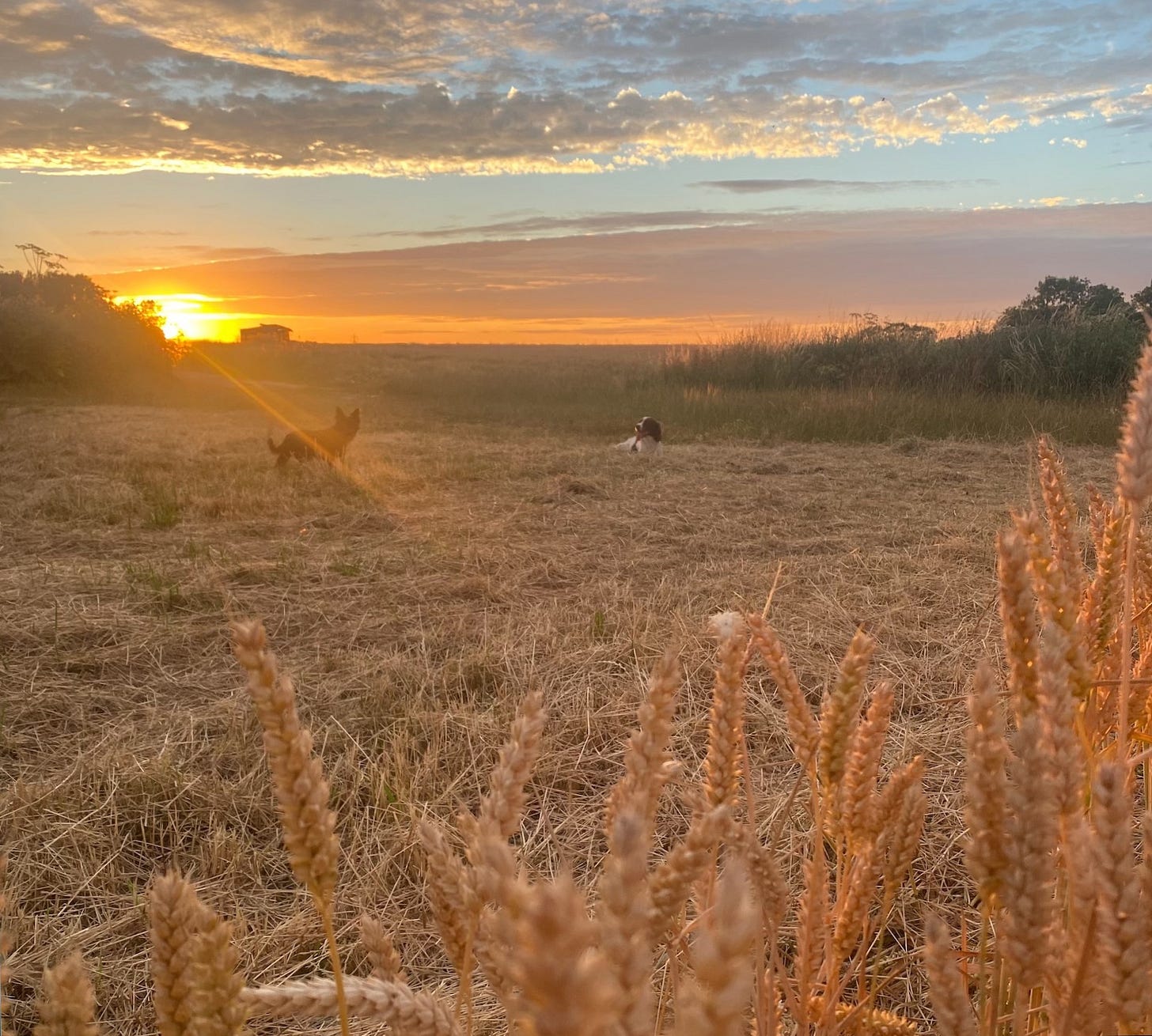

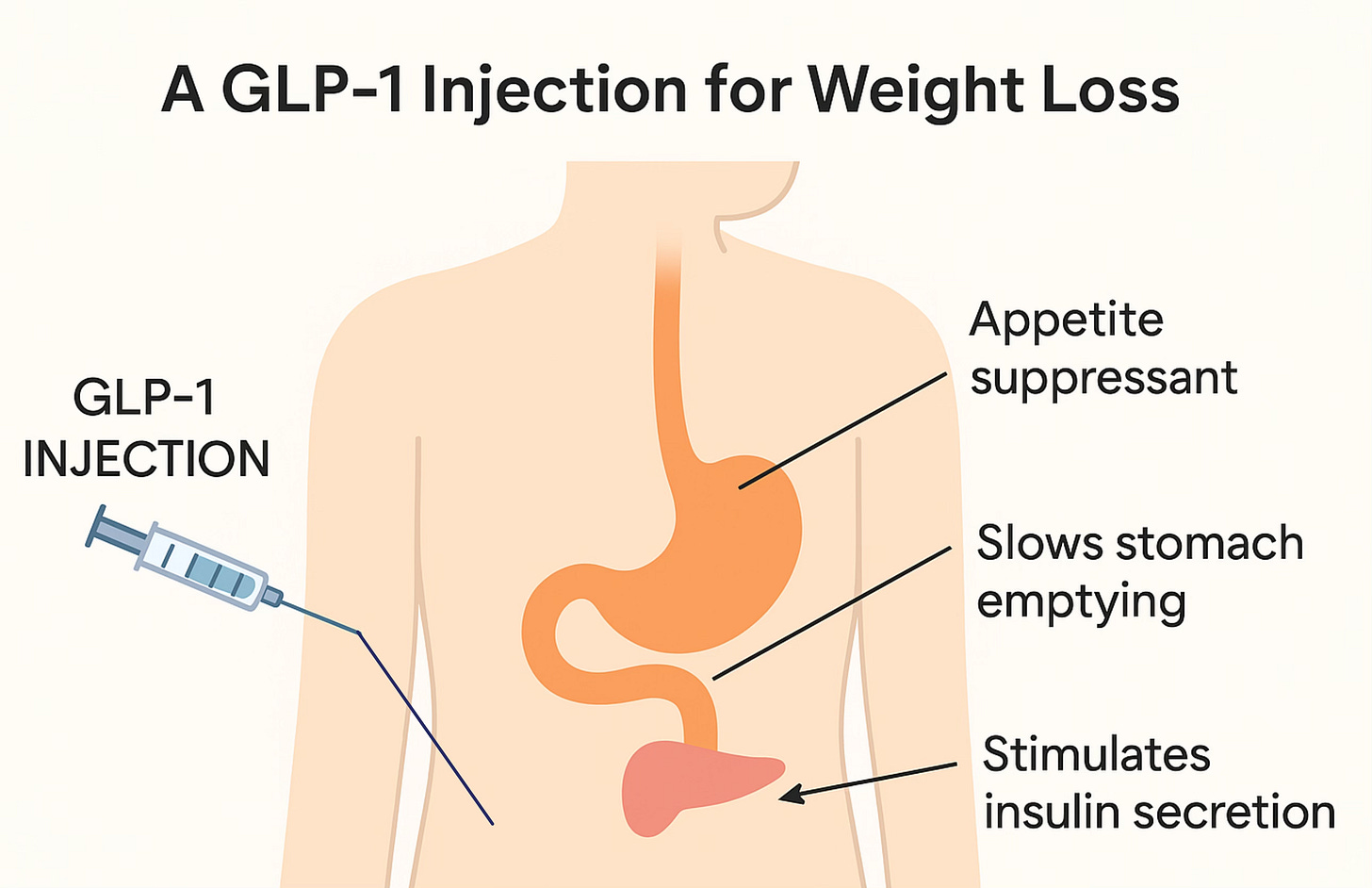
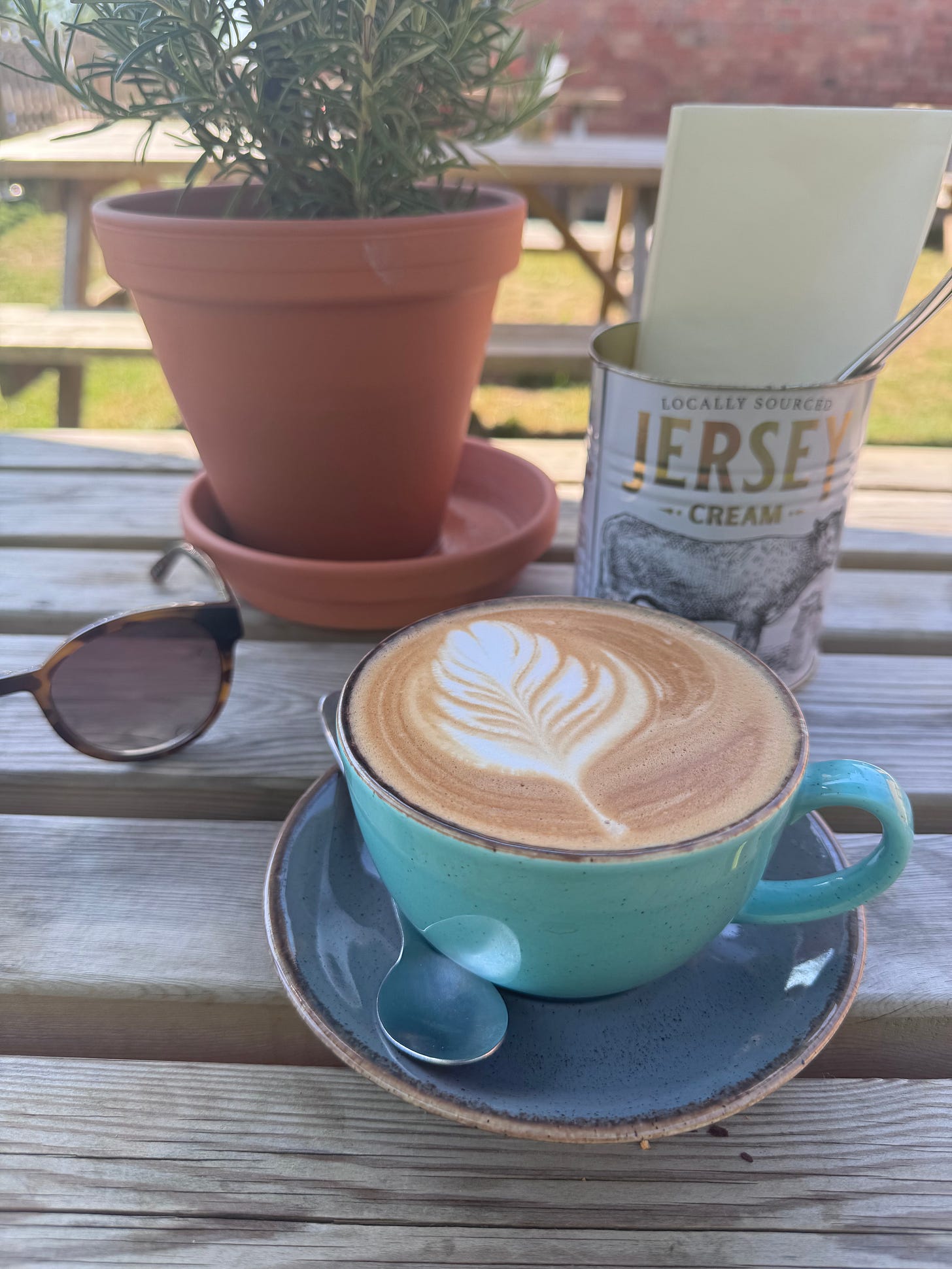




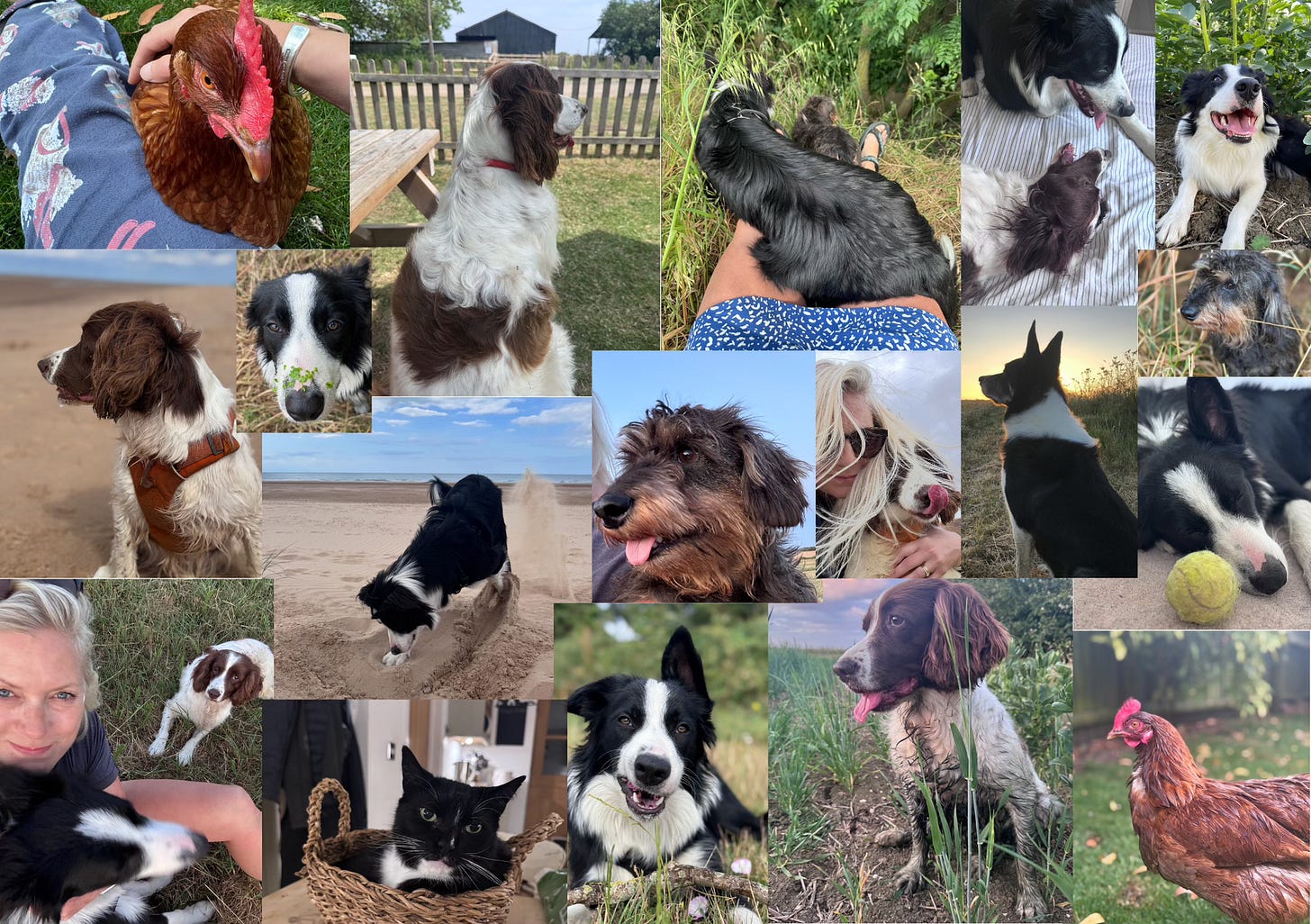
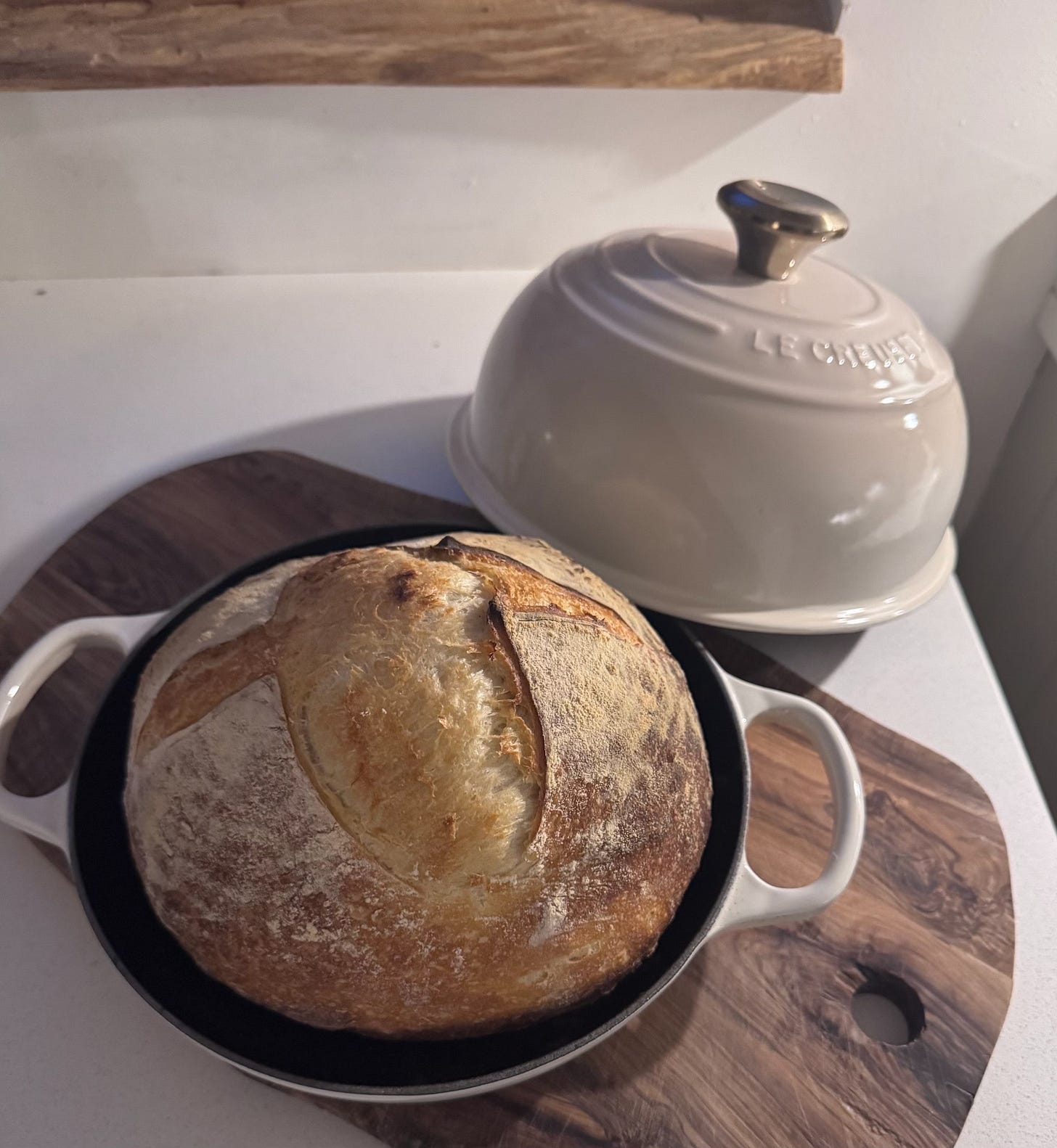
Love reading your musings, interesting topics and fun from the dog basket x